Here, we will report on the class and student activities of Kiyomizu Temple x Ritsumeikan University “Proposal for Barrier-Free Flow Lines around the Precincts of Famous Temples and Shrines in Kyoto” (instructor: Professor Shinsaku Munemoto).
Class after midterm presentation
After the interim presentation on October 24th (Sat), we held a review meeting based on the impressions and comments from the interim presentation, and had a meeting to present the results and create a video as the final product. rice field.
For the creation of videos, each class lasted 4 to 5 minutes, totaling about 15 minutes. Attention was paid to the copyright of the BGM used and consideration for portrait rights when shooting videos.
We also discussed points to keep in mind when using videos of deliverables on tablets.
In the future, we will start shooting and producing full-fledged videos. I’m really looking forward to seeing what kind of videos you can make.
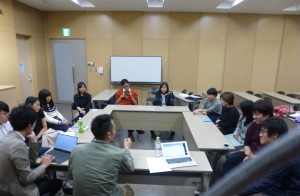
Preparing for the midterm presentation
On Saturday, October 17th, we held a presentation rehearsal for the midterm presentation at Campus Plaza Kyoto. The three teachers in charge and Mr. Kiyoaki Mori of Kiyomizu-dera Temple participated in the class and gave advice on the presentations of each group. In addition, based on the content of each group, the order of presentations at the interim presentation was decided, and as a common advice, since the presentation time per group was 1 minute and 30 seconds, 4 to 5 slides would be appropriate. , Instructions such as not to read the manuscript were given at the interim presentation.
Nakajima Group “Kiyomizu-dera’s Ultimate –Elegantly Touring, Wishing, Knowing-”
The group led by Mr. Nakajima (Ryukoku University) set up an original “spot sheet” at a highlight unique to a wheelchair and proposed a route. The teachers said that they wanted to appeal to visitors in wheelchairs, so they wanted to clarify the concept of “seeing from a little distance (preferably far away)” or “looking up at the building from a wheelchair”. There was also an opinion that it would be better to use the spot sheet, and a proposal was made that it might be possible to send only detailed photos in advance like a riddle and have them look for them on site.
In addition, the order of presentation at the recital was to decorate the 4th of the tri.
Washio Group “Sightseeing in Shimizu with less time and distance”
The group led by Mr. Washio (Ritsumeikan University) proposed a worship route that shortens both the distance and the required time in consideration of the burden on worshipers in wheelchairs. The proposal included recommending people to travel by car where it is possible to drive. In this report, the specific number of hours that can be saved was not reported, so I was instructed to check the actual time taken.
In addition, the order of presentation at the presentation was decided to be announced second.
Touhou Group “Take it easy”
Higashikata’s group (Ryukoku University) focused on the “fatigue level” caused by the difference in elevation within the Kiyomizu-dera precincts, and proposed the establishment of three rest areas. The teachers suggested that it should be easy to understand how much difference there actually is in Kiyomizu-dera Temple, and that the perspective of caregivers should be taken into consideration.
Also, at the recital, I will be the top batter.
Okazawa Group “Barrier-free Eyes”
The group led by Mr. Okazawa (Ryukoku University) discovered from the investigation of the precincts so far that the place where the fire hydrant is located is easy for wheelchair users to see. I proposed to create a map that allows you to prepare your mind at a glance. The teachers expressed their opinions that it was difficult to understand the image of “barrier-free line of sight” in the title of the presentation, and that it should be improved.
In addition, the order of presentation was 3rd.
Based on the points made here, the students will prepare for the interim presentation one week later.
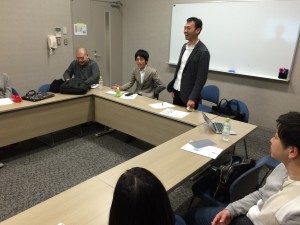
Video story/composition draft review (esquisse) Part 2
In the class on October 4th (Sun), continuing from the last time, we reviewed the themes, viewpoints, and stories of the videos that will be the deliverables. The venue was the same as last time, Entsuden of Kiyomizu-dera Temple.
In the previous review, the teachers pointed out the importance of discovering and proposing the unique pleasures of wheelchairs, rather than looking at improving things that wheelchair users cannot do. . This time, in response to these points, each team had about 30 minutes to present and comment on the concept of the video that they had reworked. We also conducted an additional survey of the precincts using the free time of the commentary.
Group 1, led by Mr. Nakajima (Ryukoku University), proposed spots unique to wheelchairs and places where people can stop. A few have been introduced. In addition, concepts were reported for signs that indicate these spots and video expressions such as zooming out. In response to this, the teachers suggested keywords such as using binoculars to observe slowly from a slightly distant point, or enjoying the view of Kyoto City from the precincts on a hill, from the idea of stopping and looking around. There was also an opinion that it would lead to the clarity of the proposal.
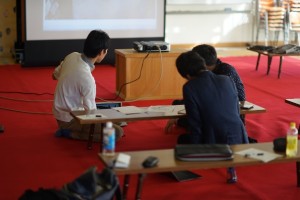
Group 2, led by Ms. Washio (Ritsumeikan University), proposed more specific ways to enjoy the event, such as drawing omikuji on the stage, rather than whether or not you could go. Investigation results were reported for route proposals that avoid
In response to this, the professors suggested that we should focus on the worship route and the time required to visit the shrine from the perspective of avoiding crowds, which has been a focus of our attention since the beginning. As a result of discussions that included team members, it was decided to include a proposal for a parking space for the courtesy vehicle on the tour route for wheelchair users.
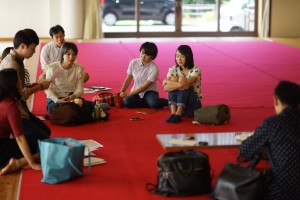
Group 3, led by Mr. Higashikata (Ryukoku University), presented suggestions for enjoying together from the perspective of caregivers. Specifically, there were reports of points where the wheelchair could be parked and rested for a while in the undulating precincts, and viewpoints that would be rewarded in relation to the direction of movement of the wheelchair. In response to this, the teachers investigated the undulations of the route around the precincts and the conditions of the ground, such as cobblestones and gravel, which strongly affect the ease of pushing wheelchairs, as information for proposing these points. There was an opinion that we should make a proposal that includes it.
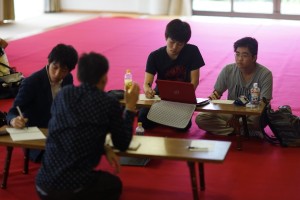
Group 4, led by Ms. Okazawa (Ryukoku University), introduced a new concept of “barrier-free eyesight” and reported on a proposal to enjoy the scenery from the perspective of a wheelchair. We set the stage, Koyasu Pagoda, and Otowa Falls as places where wheelchair users can enjoy themselves, and proposed ideas for how to do so. The teachers suggested setting more detailed points to avoid handrails and crowds as attractions for wheelchair users. It was arranged as a proposal to plot the highlights on the current barrier-free route in more detail, and to provide information on which side of the route should be placed on the route.
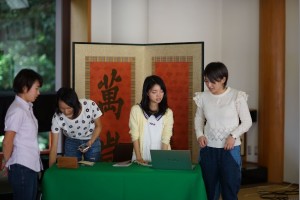
After the presentations by each group, the work contents for the summary and the interim report were organized. In the evening, narration training was held at Campus Plaza.
Video story and composition draft review (esquisse)
In class on August 23rd (Sunday), a critique meeting was held at Entsuden of Kiyomizu-dera Temple for the draft of the video story that will be the deliverable.
In this class, which was held at Kiyomizu-dera Temple on Saturday, July 18, each group conducted fieldwork in the precincts using wheelchairs. After that, as an extracurricular study, the students worked in groups to summarize the results of their fieldwork, and worked out a draft of the video story that would be the final deliverable. This class is a review meeting for the first draft.
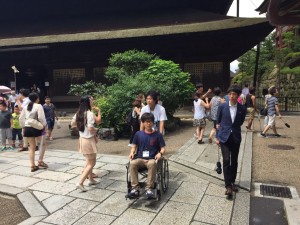
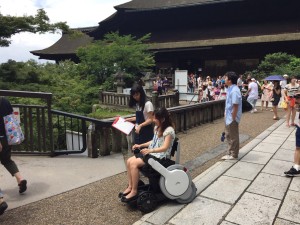
Fieldwork in the previous class
At the beginning of the class, the teacher gave a lecture on how to use video editing software and the differences between how to make videos on Windows and Mac, etc., for future video creation.
In the evaluation session that followed, each group had 40 minutes to give presentations on their proposals and receive feedback from the teachers.
In Group 1, led by Mr. Nakajima (Ryukoku University), the view of the building from a wheelchair is different from normal. , Koyasu Pagoda and Otowa Waterfall were reported. In addition, there are places where the path for wheelchairs becomes narrow depending on the slope of the approach road, so we suggested that improvements should be considered.
In response to this, the teachers suggested that by narrowing down the points unique to wheelchairs, it would be possible to create a more meaningful route for wheelchairs, which are difficult to move around.
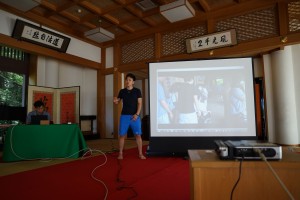
Group 2, led by Mr. Washio (Ritsumeikan University), was originally supposed to propose a route that runs in the reverse direction of the general route, but after conducting a field survey, it was not possible due to the large number of general visitors. Due to the difficulty, a route was proposed to avoid congestion when visiting the regular route. In addition, since the route to Koyasuto and Jishu Shrine is difficult for wheelchairs, we proposed the installation of a lift for wheelchairs, especially to Jishu Shrine.
In response to this, the teachers suggested adding original discoveries to the proposals and finding ways to avoid crowds and still be enjoyable for wheelchair users.
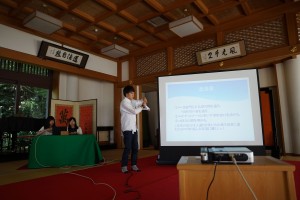
Group 3, led by Mr. Higashikata (Ryukoku University), proposed the installation of new slopes to the Suikyudo and Niomon gates, as well as the creation of rest spaces for caregivers.
In response to this, the teachers suggested that, from the perspective of feasibility, we should think of a way for wheelchair users to enjoy themselves in the current environment of Kiyomizu-dera, and that we should develop the idea of a caregiver’s perspective. was issued.
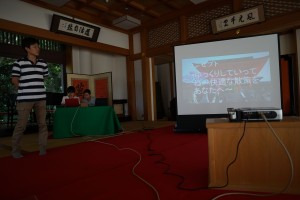
Group 4, led by Mr. Okazawa (Ryukoku University), has a concept of “sharing emotions (for wheelchair users and caregivers)” and introduces a machine that eliminates the difference in the height of the line of sight at the highlight spot. In addition, we investigated examples of using videos of other companies, etc., and proposed that it would be effective to have a guide appear in the video and to insert a telop.
The professors suggested that using large-scale machinery would be difficult in terms of feasibility, and that it would be possible to consider a simpler method that would achieve the same effect. rice field.
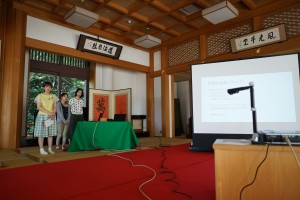
After each group’s presentation, the teacher gave a summary and explained future work policies.
Continuing from the previous session, the students used wheelchairs to conduct additional surveys and photographs of the grounds of Kiyomizu-dera Temple during their free time during their presentations.
The next class will also be held at Kiyomizu-dera Temple, and each group will work on the concept of the video.
First day of the project x Kiyomizu-dera visit
On June 21st (Sunday), a class was held by Professor Somoto of Ritsumeikan University, whose activities are centered around Kiyomizu Temple. Munemoto-sensei’s class was held on May 30th (Saturday) jointly with other subjects, and the opening ceremony and general orientation was the first class, so this was the first class to be held independently. On the first day of the project, classes were held at Kiyomizu Temple.
The theme of Professor Somoto’s class is to “discover new attractions of Kiyomizu-dera and propose further ‘universal design’.”
With a history of over 1200 years, Kiyomizu-dera is one of the most popular tourist destinations in Kyoto, with over 50 million tourists visiting annually (2013). Kiyomizu-dera Temple was built at the foot of Mt. Kiyomizu-dera has been making the temple grounds barrier-free for more than ten years by paving the approach road and installing slopes so that wheelchair users and the elderly can also visit. You can go around the precincts.
In Munemoto’s class, from the perspective of barrier-free access, students will explore the highlights of Kiyomizu-dera Temple grounds, propose the attractions they discover and new routes around them, and produce a video introducing them as the final product. The purpose is that.
The class began with a lecture on the history and transformation of Kiyomizudera by Kiyoaki Mori of Kiyomizudera. In the lecture, Kiyomizu-dera has a history of 1,200 years of respecting traditions and cultural assets, while at the same time challenging numerous changes. The fact that Kiyomizu-dera has overcome crises such as wars is the result of the constant support of local people for 1,200 years.
After Mr. Mori’s lecture, the students were divided into groups using a unique method that Professor Munemoto himself experienced when he studied abroad when he was a student. From now on, activities will be based on this group.
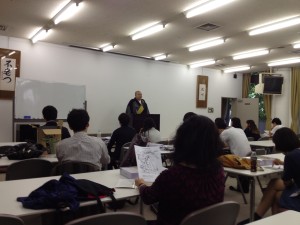
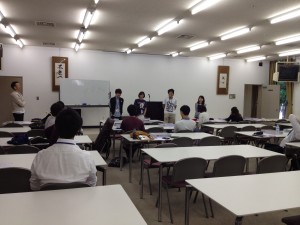
After that, each group toured the grounds of Kiyomizu-dera Temple under the guidance of Mr. Mori. The halls and gates of Kiyomizu-dera were destroyed and rebuilt in different periods due to fires, etc., and even the existing ones were built at different times. He explained carefully about each of Kiyomizudera’s cultural assets, including the fact that the designs and styles differ depending on the era in which they were built, the Kannon statue that has a unique appearance at Kiyomizudera, and stories about hidden Buddhist images. In addition, he explained the ideas and points for making the precincts barrier-free while actually showing us around the site.
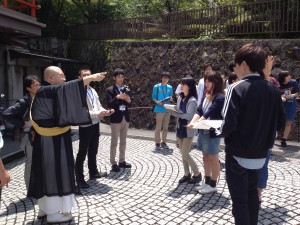
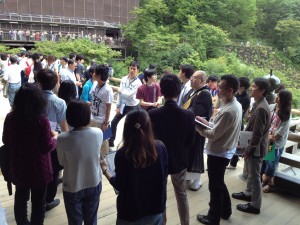
After the tour of the precincts, each group immediately held a strategy meeting, and some groups went out to investigate the precincts again. There are high expectations for the future efforts of the students, whether they will be able to discover unknown attractions at Kiyomizu-dera Temple, which is a cultural heritage and tourist destination that represents Japan.















